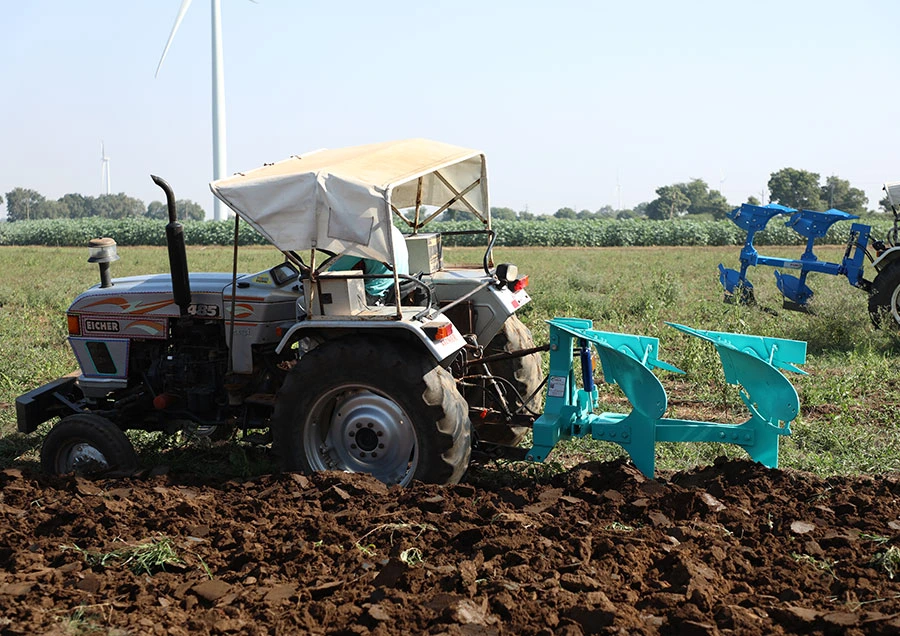Chat With Us
+91 99253 37969Ploughing vs. Harrowing: The Key Differences Every Farmer Should Know

Ploughing and harrowing are two critical steps in agriculture. If implemented profoundly, both processes help in enhancing crop productivity and quality. But what are the differences between ploughing and harrowing?
Although there are some similarities in the methods of both these activities, they differ in many aspects such as purpose, timing, and used equipment. Today, we are going to discuss about these differences and understand both processes.
A Comprehensive Differentiation Between Ploughing and Harrowing
Ploughing
Ploughing is one of the oldest agricultural practices known to humanity and involves the turning over of the soil to bury weeds, crop residues, and other organic matter. The primary tool used for ploughing is the plough, typically drawn by a tractor or other powered machinery. The plough's blades penetrate the soil, breaking it up and turning it over, effectively aerating and loosening the earth.
Key Aspects of Ploughing:
1. Depth:
Ploughing depth varies depending on factors such as soil type and crop requirements. The depth also depends on the intended purpose. For example, the ploughing depth for the plantation of pulses varies for the plantation of cereals.
However, ploughing has two common methods: shallow and deep. Where shallow ploughing depth ranges up to 5 inches, deep ploughing can go up to 20 inches.
2. Purpose:
The main purpose of ploughing is to prepare the soil for planting by creating a loose and aerated seedbed. It also helps to control weeds and improve water infiltration. These collaborative results promote proper growth and productivity.
Furthermore, ploughing is crucial to aerate the soil. By loosening the tough soil layers it creates pores to ensure proper air pathways and helps to fulfill oxygen demand.
3. Timing:
Ploughing is typically performed before planting or sowing seeds. It allows sufficient time for the soil to settle and stabilize before the next stage of cultivation. The timing depends on seasonal crops and climate. But, spring is considered the best suitable time for ploughing to prepare seed beds for the upcoming growing season.
4. Equipment
Ploughing is typically carried out using specialized equipment called ploughs which come in various designs and configurations to suit different soil types and cultivation practices. Traditional ploughs feature a curved blade called a moldboard known as a mouldboard plough. It slices through the soil and turns it over as the plough is drawn through the field by a tractor or draft animals.
Modern ploughs like disc ploughs can incorporate additional features such as adjustable cutting depths, variable blade angles, and specialized attachments for specific soil conditions or cropping systems. However, the choice of ploughing equipment depends on factors, field type and soil conditions.
Also Read: Disc Plough And Mouldboard Plough: Which is Best for Your Field?
Harrowing
Harrowing complements ploughing by further refining the seedbed and preparing it for seeding or planting. It focuses on soil inversion, harrowing works on the surface, breaking up clods, leveling the soil, and incorporating organic matter. Harrows come in various types, including disc harrows, chain harrows, and tine harrows, each suited to different soil conditions and cultivation objectives.
Key Aspects of Harrowing
1. Surface Preparation:
Harrowing focuses on refining the surface layer of the soil after ploughing to create an optimal seedbed for planting or seeding. The primary objective is to break up clods and level the soil surface. It helps create a fine tilth which promotes seed-to-soil contact and uniform seed germination.
Harrowing also helps incorporate organic matter and fertilizer evenly into the soil and ensures that nutrients are readily available to emerging seedlings.
2. Weed Control:
By disrupting weed seedlings and exposing them to sunlight and air. Harrowing helps suppress weed growth and reduces competition with crops. Furthermore, It helps in burying the weeds that come to the surface while ploughing.
It also helps to spread fertilizers and pesticides evenly across the surface which reduces weed growth. Therefore, harrowing is a crucial process for improving productivity by promoting weed control.
3. Timing:
Harrowing is typically performed after ploughing but before planting or seeding. However, it can also be done during the growing season to control weeds and loosen compacted soil. The timing of harrowing depends on factors such as soil moisture content, weather conditions, and crop growth stage.
It is most effective when the soil is moist but not overly wet. This is because excessive moisture can lead to soil compaction and damage to emerging seedlings. Harrowing at the right time helps farmers achieve optimal seedbed conditions and maximize crop productivity.
4. Equipment:
Harrowing can be accomplished using various types of equipment. It includes disc harrows, chain harrows, tine harrows, and rotary harrows. Each type of harrow has its unique design and operation. However, their functionality and productivity vary according to specific soil types or cultivation practices. Disc harrows, for example, are effective for breaking up soil clods and chopping crop residues, while chain harrows are excellent for surface levelling and seedbed preparation.
Conclusion
In summary, ploughing and harrowing are two important components of agriculture and play crucial roles in enhancing productivity. Ploughing prepares for seed sowing and harrowing helps in germination. Although both processes have different working principles but have the same effective result in crop production.





